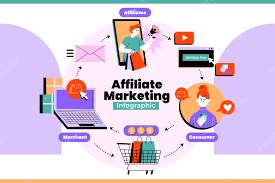
E-commerce refers to the buying and selling of goods, services, or information over the internet or electronic networks. It encompasses a wide range of activities, including online retail, electronic payments, online auctions, and internet banking. The advent of e-commerce has revolutionized the traditional brick-and-mortar retail model, providing businesses with new opportunities to reach a global customer base and offering consumers the convenience of shopping from anywhere at any time.
Forms of E-commerce
Business-to-Consumer (B2C): B2C e-commerce involves transactions between businesses and individual consumers. It is the most familiar form of e-commerce, where online retailers offer products and services directly to customers through websites or mobile applications.
Business-to-Business (B2B): B2B e-commerce involves transactions between businesses. This form of e-commerce facilitates the exchange of goods, services, or information between different companies, such as manufacturers, wholesalers, and retailers. B2B e-commerce often involves electronic data interchange (EDI) systems, which allow for seamless communication and transactions between organizations.
Consumer-to-Consumer (C2C): C2C e-commerce enables consumers to sell products or services directly to other consumers through online platforms. Popular examples of C2C platforms include online classifieds, auction sites, and peer-to-peer marketplaces.
Consumer-to-Business (C2B): C2B e-commerce occurs when individual consumers offer their products or services to businesses. This can include freelance work, consulting services, or user-generated content.
With the rapid growth of the e-commerce industry, it has become crucial for online store owners to find effective ways to stand out and boost sales. While setting up an e-commerce store is relatively easy, achieving consistent profitability requires careful planning and implementation of strategies.
In this article, we will explore seven valuable tips that can help you make your e-commerce store sell more and maximize your online success.
Optimize Your Website for User Experience
One of the key factors influencing customer conversions is the overall user experience on your website. Ensure your site is visually appealing, easy to navigate, and mobile-responsive. Implement intuitive product categories, prominent search functionality, and user-friendly filters to help customers find what they need quickly.
Streamline the checkout process and offer secure payment options to minimize cart abandonment. Additionally, optimize page loading speed, as a slow website can deter potential buyers.
Invest in High-Quality Product Images and Descriptions
Visuals play a crucial role in e-commerce sales. Provide high-resolution product images from multiple angles, allowing customers to get a clear idea of what they're purchasing. Use professional photography and consider including zoom and 360-degree viewing options.
Additionally, compelling product descriptions that highlight the benefits and features can help convince potential buyers. Optimize your descriptions with relevant keywords for better search engine visibility.
Leverage the Power of Social Media
Social media platforms are powerful tools for reaching a wider audience and driving traffic to your e-commerce store. Identify the platforms where your target audience is most active and create engaging content to promote your products.
Utilize visually appealing images and videos, run contests or giveaways, collaborate with influencers, and encourage user-generated content. Engage with your followers by responding to comments and messages promptly, building a strong brand presence and fostering customer loyalty.
Implement Effective Search Engine Optimization (SEO) Strategies
To drive organic traffic to your e-commerce store, optimize your website for search engines. Conduct thorough keyword research to identify relevant terms and incorporate them into your product descriptions, meta tags, titles, and URLs. Generate informative and engaging content such as blog posts, buying guides, and tutorials to attract potential customers and improve your search engine rankings. Focus on building high-quality backlinks from reputable websites to enhance your site's authority.
Offer Incentives and Personalization
To encourage customers to make a purchase, consider offering incentives such as discounts, free shipping, or loyalty rewards. Limited-time offers and exclusive deals can create a sense of urgency and drive immediate sales. Implement personalized recommendations based on customers' browsing and purchasing history to showcase relevant products and enhance the shopping experience. Leverage email marketing campaigns to reach out to existing customers and offer them personalized promotions.
Provide Excellent Customer Service
Exceptional customer service is crucial for building trust and fostering repeat business. Respond promptly to customer inquiries and provide detailed and helpful information. Offer multiple channels for customer support, including live chat, email, and phone. Implement a hassle-free return policy to alleviate customer concerns and ensure a positive shopping experience. Encourage customers to leave reviews and testimonials, as positive social proof can significantly influence buying decisions.
Continuously Analyze and Optimize Performance
Regularly monitor and analyze key performance metrics to identify areas for improvement. Utilize analytics tools to track website traffic, conversion rates, average order value, and customer behavior. Identify popular products and optimize their visibility on your website. Conduct A/B testing for different elements such as website layout, product descriptions, and call-to-action buttons to determine the most effective variations. Use the insights gained to refine your marketing strategies and enhance overall store performance.
Benefits of E-commerce
Global Reach: E-commerce breaks down geographical barriers, allowing businesses to expand their reach beyond local markets and tap into a global customer base. With an online presence, companies can target customers in different regions or countries, thereby increasing their market potential.
Convenience and Accessibility: E-commerce provides unparalleled convenience for consumers. Online shopping enables customers to browse and purchase products or services at their convenience, 24/7, without the need to visit physical stores. It eliminates the constraints of time and distance, making shopping accessible to people with busy schedules or limited mobility.
Cost Efficiency: E-commerce offers cost advantages for both businesses and consumers. Online retailers can avoid the expenses associated with maintaining physical stores, such as rent, utilities, and staffing costs. This often translates into lower prices for customers, as online retailers can pass on their cost savings through competitive pricing.
Personalization and Targeted Marketing: E-commerce platforms leverage data analytics and customer behavior tracking to provide personalized recommendations and targeted marketing campaigns. By understanding consumer preferences and purchase history, businesses can deliver tailored shopping experiences, increasing customer satisfaction and loyalty.
Challenges of E-commerce
Security and Privacy Concerns: E-commerce transactions involve the exchange of sensitive information, such as credit card details and personal data. Protecting customer information from unauthorized access or data breaches is a significant challenge for e-commerce platforms. Implementing robust security measures, encryption protocols, and complying with privacy regulations are essential to ensure consumer trust and confidence.
Logistics and Supply Chain Management: Efficient order fulfillment, inventory management, and timely delivery are crucial aspects of e-commerce operations. Managing complex supply chains, coordinating multiple vendors, and handling product returns require meticulous planning and robust logistics infrastructure.
Customer Trust and Experience: Building trust with online customers can be challenging, as they cannot physically inspect products before purchase. Providing accurate product descriptions, high-quality images, customer reviews, and reliable customer service are vital to establish trust and deliver exceptional customer experiences.
Intense Competition: The growth of e-commerce has led to increased competition, as businesses strive to differentiate themselves in crowded online marketplaces. Standing out in a sea of competitors requires effective marketing strategies, unique value propositions, and continuous innovation.
Impact of E-commerce
Business Transformation: E-commerce has transformed traditional business models, enabling companies to adapt to changing consumer behavior and market dynamics. It has opened new avenues for startups, expanded revenue streams for existing businesses, and facilitated the rise of digital-first enterprises.
Job Creation and Economic Growth: E-commerce has created numerous job opportunities, particularly in the areas of digital marketing, web development, logistics, and customer service. It has also contributed to economic growth by expanding trade and fostering entrepreneurship.
Disruption of Traditional Retail: The growth of e-commerce has disrupted the traditional retail landscape, leading to the closure of many brick-and-mortar stores. To survive, traditional retailers have had to embrace e-commerce or adopt omnichannel strategies that seamlessly integrate online and offline channels.
Changing Consumer Behavior: E-commerce has profoundly influenced consumer behavior, with online shopping becoming increasingly prevalent. Consumers now expect convenience, personalized experiences, and competitive pricing, prompting businesses to adapt and innovate to meet these evolving demands.
In conclusion, in the highly competitive e-commerce landscape, implementing effective strategies to drive sales is essential for the success of your online store.
By optimizing user experience, investing in high-quality visuals and product descriptions, leveraging social media, implementing SEO strategies, offering incentives and personalization, providing excellent customer service, and continuously analyzing and optimizing performance, you can make your e-commerce store sell more and increase your revenue.
Remember, building a successful e-commerce business takes time and dedication, so be patient and adaptable to evolving market trends.























